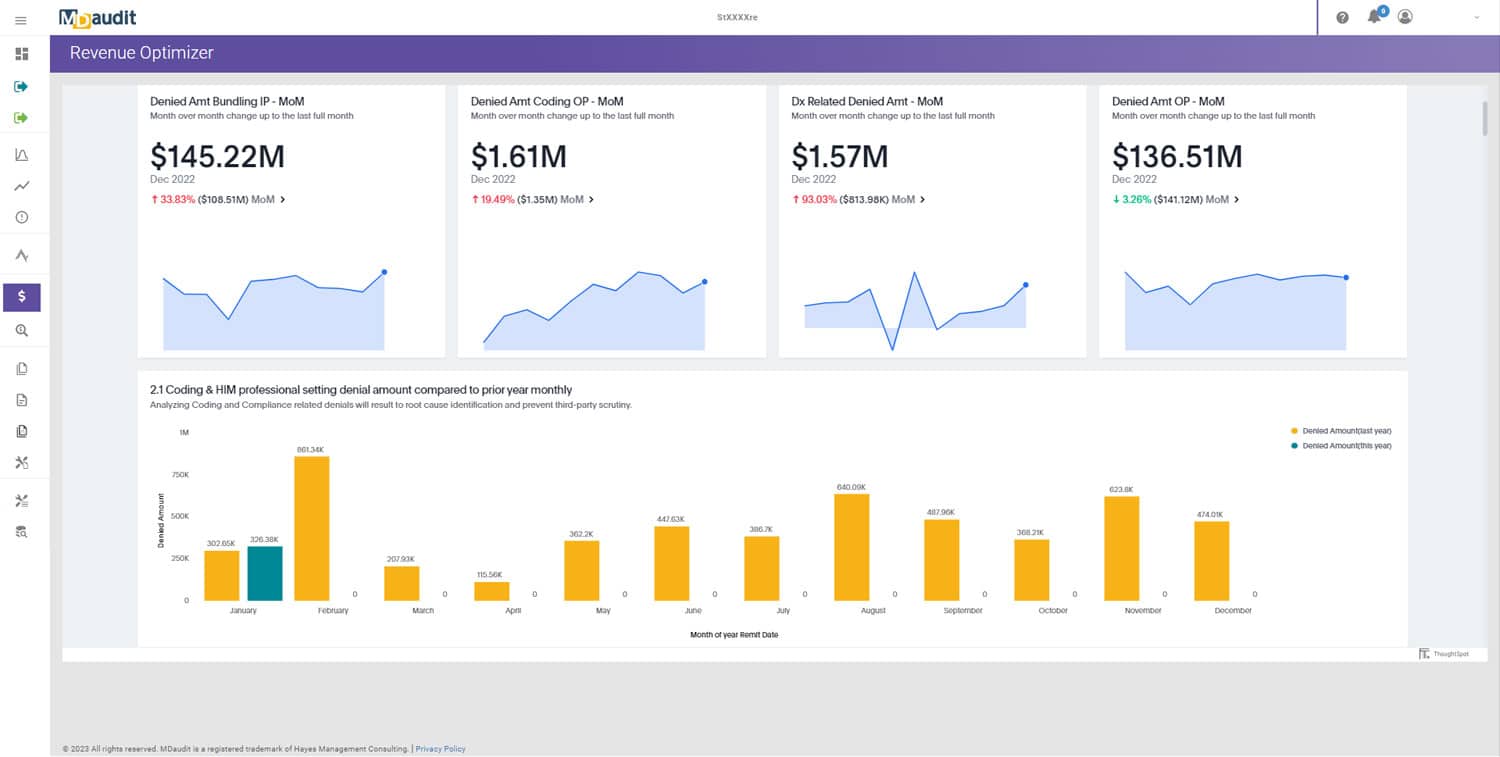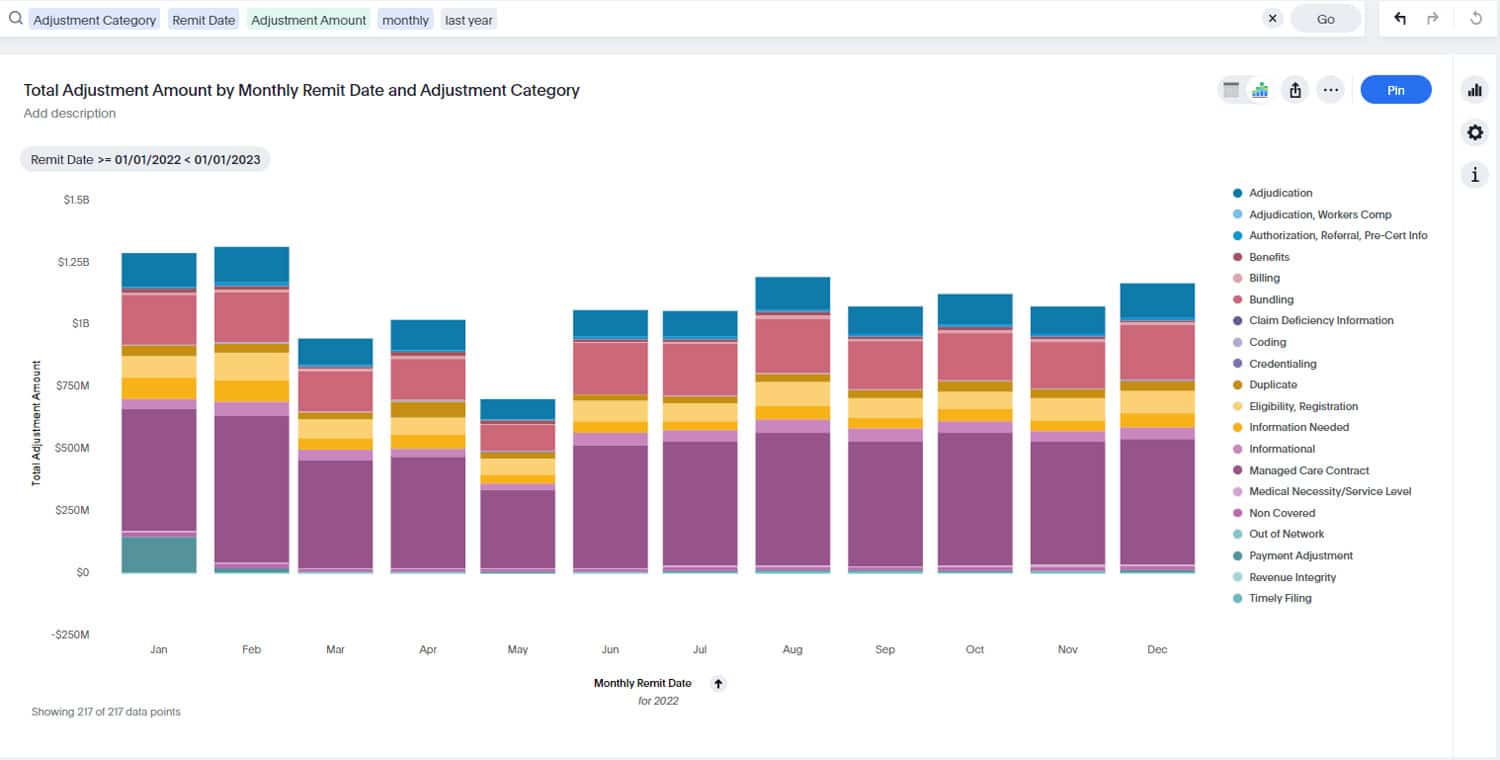In today’s healthcare environment, scale is both a strategic advantage and a compliance challenge. As health systems expand through mergers, acquisitions, and service line growth, maintaining consistent revenue integrity across facilities becomes increasingly complex. Each location may operate different electronic health record (EHR) systems, coding processes, and payer relationships, making it difficult to maintain visibility and control.
Revenue integrity leaders face a clear mandate: unify operations, standardize processes, and eliminate silos without disrupting the financial engine that supports patient care. The question is how to scale efficiently while maintaining accuracy, compliance, and agility.
MDaudit helps organizations accomplish exactly that, centralizing compliance oversight, audit workflows, and denial prevention across multi facility networks. By using intelligent automation, analytics, and real time collaboration, organizations can scale revenue integrity with confidence.
The Challenge of Scaling Revenue Integrity
Fragmented Processes, Fragmented Visibility
When health systems operate across multiple hospitals, clinics, and ambulatory centers, workflows often evolve independently. Each facility may rely on different data definitions, coding standards, or reporting formats. This fragmentation leads to:
- Inconsistent audit methodologies
- Redundant or conflicting reports
- Delayed identification of compliance risks
- Limited visibility into payer performance across the enterprise
Without unified insight, executives must make decisions based on incomplete or outdated information, creating operational and financial blind spots.
Varying Payer Relationships
Each facility may serve different markets and payer mixes, leading to inconsistent denial patterns and reimbursement models. A multi facility view enables leaders to spot systemic payer behaviors, identify shared risk areas, and negotiate from a position of data backed strength.
Resource Limitations
Revenue integrity teams are often centralized, yet they support dozens of service lines and facilities. The absence of automated oversight forces teams into a reactive posture, spending time aggregating data instead of analyzing it.
The Case for Centralized Revenue Integrity
Centralizing revenue integrity does not mean removing local autonomy; it means creating a standardized framework where local teams operate within a shared compliance, audit, and reporting environment. This structure enables:
- Enterprise wide visibility into risk and performance
- Consistent audit standards
- Streamlined escalation and corrective action workflows
- Scalable reporting for leadership and compliance committees
With a unified framework, organizations can move from reactive problem solving to proactive revenue governance.
Building the Foundation for Scalable Revenue Integrity
1. Standardize Audit Workflows Across Facilities
A foundational step toward scalable revenue integrity is the adoption of consistent, automated audit workflows. Using Audit Workflows, organizations can create standardized templates and escalation rules that apply system wide. Each audit, whether inpatient, outpatient, or specialty specific, follows the same structure, ensuring comparable results and repeatable processes.
Standardization supports both scalability and defensibility. Compliance leaders can demonstrate uniform oversight practices to regulators and payers, regardless of facility location or service line complexity.
2. Centralize Data Collection and Reporting
To scale effectively, data must flow into a single, transparent ecosystem. This requires integrating multiple EHRs, billing systems, and claim scrubbers into one environment where data is normalized and accessible. MDaudit’s analytics and integration capabilities make this possible, reducing manual effort while increasing reliability.
When audit results, denials data, and performance metrics live in a unified system, leaders can evaluate enterprise performance at a glance or drill down to a specific provider, facility, or payer pattern.
3. Leverage Predictive and Behavioral AI
Scaling human oversight across large networks is impossible without automation. MDaudit’s Artificial Intelligence (AI) at MDaudit applies behavioral intelligence and predictive analytics to identify emerging risks across all facilities. The system detects anomalies in claim volume, denial types, or documentation patterns that signal underlying issues.
By prioritizing where teams should focus next, AI extends capacity, helping small compliance teams oversee vast operational landscapes without additional staffing.
4. Prioritize Data Transparency and Security
Centralizing revenue data requires confidence in data governance. MDaudit’s data transparency framework ensures every audit and claim record is traceable, while data security protocols protect sensitive information across facilities and vendor relationships. Secure, transparent data is essential for sustaining compliance credibility and regulatory readiness at scale.
5. Create Facility Scorecards
To maintain engagement and accountability, each facility should receive periodic performance scorecards. These dashboards track audit accuracy, denial rates, response time, and education completion. Facility leaders can compare results across the network, identifying where additional resources or training are needed.
The same principles apply to provider and coder scorecards, which transform audit outcomes into actionable education and performance improvement tools.
From Data to Decision: The Power of Analytics
Identifying Enterprise Wide Trends
When analytics unify data from multiple facilities, patterns emerge that are invisible at the local level. Leaders can see:
- Which facilities experience higher denial rates for specific payers
- Where documentation quality correlates with audit accuracy
- Which departments consistently exceed compliance thresholds
Revenue Optimizer visualizes these insights, enabling executives to make targeted, data informed decisions that drive financial and compliance performance simultaneously.
Managing Cross Facility Payer Relationships
Payer behavior analysis helps organizations understand not only how individual payers perform but also how their behavior varies across facilities. For example, a payer may consistently deny a specific procedure code at one hospital but not another. Such inconsistencies often reflect documentation or contract differences that can be corrected system wide once identified.
Benchmarking and Continuous Improvement
Analytics also supports benchmarking. Facilities can measure their audit accuracy and denial rates against system averages or national benchmarks. Continuous feedback loops encourage improvement and enable leadership to track progress toward enterprise compliance goals.
Case Studies in Scalable Revenue Integrity
Case 1: Regional Health Network Unifies Oversight
A regional health system operating six hospitals faced inconsistent coding audit practices. Each site used different templates and tracked results separately. By adopting MDaudit’s centralized Audit Workflows, the organization standardized its audit process, implemented cross facility scorecards, and reduced audit turnaround time by 35%. Leadership gained a single, defensible view of compliance performance across all hospitals.
Case 2: Academic Medical Center Applies Predictive Insights
An academic health system with multiple outpatient centers leveraged AI Powered Technology to detect coding anomalies and payer shifts across service lines. The AI models flagged a pattern of high cost drug denials that appeared across three locations. Targeted intervention reduced related denials by 27% within two quarters.
Case 3: Multi State System Improves Data Integrity
A large nonprofit health network integrated data from ten billing systems into one MDaudit environment. Using centralized analytics, compliance teams could view claims and audits across all facilities in real time. The result was a 20% increase in audit accuracy and a 15% decrease in days spent reconciling audit data.
Implementing Scalable Governance
Scaling revenue integrity successfully requires an intentional governance structure that supports collaboration and accountability. Key steps include:
Define Clear Ownership
Assign roles for corporate compliance, revenue integrity, and local facility liaisons. Define who manages audits, who owns data submission, and how results flow upward.
Standardize Policies and Education
Ensure every facility follows the same audit and documentation policies. Centralize training resources so that coders, auditors, and clinicians receive consistent guidance regardless of location.
Leverage Cross Functional Committees
Create committees that include compliance, health information management (HIM), coding, finance, and clinical leadership. Regular meetings ensure cross facility alignment and rapid escalation of issues.
Use Reporting to Drive Accountability
Consistent reporting through scorecards and dashboards keeps leaders informed and engaged. Transparency at all levels encourages ownership and continuous improvement.
Leveraging MDaudit’s Ecosystem
Scaling revenue integrity is not just about tools, it’s about building a connected ecosystem that supports operational resilience. MDaudit’s solutions work in concert to provide that ecosystem:
- Audit Workflows automate reviews and standardize compliance oversight
- Revenue Optimizer delivers enterprise wide financial and operational analytics
- AI at MDaudit enables predictive risk detection and performance forecasting
- Data transparency ensures every decision is supported by clear, traceable data
- Customer experience initiatives support user adoption and continuous improvement across distributed teams
These capabilities allow organizations to grow their operations without losing control of compliance or visibility.
Future Outlook: Intelligent Scaling
The next evolution of multi facility revenue integrity will merge automation, AI, and behavioral analytics into a continuous oversight model. Future ready systems will:
- Predict emerging payer policy shifts before they impact claims
- Personalize audit recommendations by facility and service line
- Integrate education workflows that adapt dynamically to performance trends
By connecting every facility through shared data, unified governance, and predictive intelligence, organizations can scale compliance without scaling complexity.
Achieving Enterprise Revenue Integrity
Scaling revenue integrity across multi facility health systems requires more than consolidation, it demands coordination, consistency, and intelligent automation. The organizations that succeed will be those that treat revenue integrity as an enterprise function, not a local process.
With tools like Audit Workflows, Revenue Optimizer, and AI at MDaudit, compliance leaders can unify oversight, standardize operations, and ensure every claim is accurate, defensible, and optimized, no matter how many facilities they manage.








